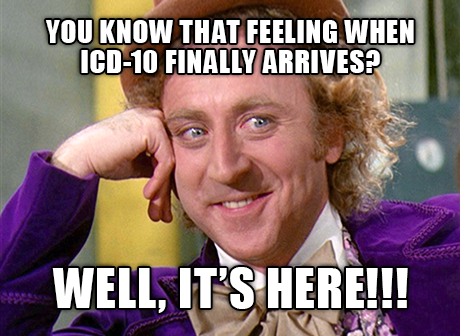It’s Finally Here!
It seems like forever ago…
It seems like forever ago we began talking about this thing called ICD-10. Delay after delay, extension after extension and here we are. Thursday is the day the American healthcare industry has long been anticipating.
ICD-10 is finally here!

Boil it all down
Boil it all down, for EMS the departure is not huge for the street provider. Come Thursday, people will still pick-up the phone to call 9-1-1. Dispatchers will still alert ambulance services. Crews will respond, treat the patient and transport people to hospitals all across America.
Act. Respond. Repeat.
Following the EMS incident, EMS first responders will author a Patient Care Report (PCR) to chronicle the scenario and move the PCR through QA/QI and onto a billing office.
Now, we see the change.
More Stuff
For the billing office, ICD-10 means more stuff. Actually 55,000 more stuff. But, then again, ambulance billing does not carry quite the complexity of some healthcare practices so we have learned that the actual code-set affecting EMS is potentially a bit more limited than we had first feared back a few years ago when all of this was just a whisper of a discussion.
Really it all is about the detail. Your EMS billing office will be looking for more detail in the PCRs you produce than at any time since you’ve been an EMS provider. If you have a really good EMS billing office, you should have been required to include clear clinical documentation to describe your ambulance run in greater detail over the past few years anyway.
Compliance is the name of the game in EMS billing. Staying above board, following all of the rules and collaborating with the street staff regarding documentation that clearly presents a picture in words regarding the patient’s illness or injury is what is important.
In the end, it all loops back to documentation.
Your billing office will be successful in the new coding paradigm if you present the most detailed PCR you can produce. All the mechanics of what happens after you hit “Save” in the ePCR program happens without your even knowing about it.
Hopefully your billing office is completely prepared.
Fear of the Unknown
What is unsettling for the billing office staff, is the unknown of how this is all going to play out. We have received bits and pieces of instruction, especially in the last month or so. However, there are still commercial insurance payers that have yet to issue more than just a summary regarding implementation. Plus, most if not all of the communication that crosses our desk in the billing office pertains to physicians and institutional medical practice with little to no mention of how this all applies to the ambulance world.
As we have mentioned in this space, Novitas Solutions- the Medicare Administrative Contractor for Pennsylvania, New Jersey, Maryland, Delaware and the metro area surrounding the District of Columbia plus Colorado, New Mexico, Texas, Oklahoma, Arkansas, Louisiana and Mississippi has been up-front with their guidance. We are anticipating NGS to soon issue their own guidance for Illinois, Michigan, Wisconsin, New York, Rhode Island, Massachusetts, New Hampshire, Connecticut and Maine in the form of a Local Coverage Determination.
Then there are each State’s Medicaid programs, all of the Medicare and Medicaid Managed Care plus commercial health insurances that each must weigh-in with their expectations.
If it all sounds a bit overwhelming…well, it is to an extent.
Everybody’s in the same boat…
Sink or swim, this thing’s going to happen whether we like it or not. Our suggestion…roll with it because everyone’s in the same boat.
Our helpful hints to you…
- Understand if your EMS billing office is a bit frazzled for the next few weeks. Change isn’t easy and for them, this change is a big one! Try to be a bit understanding.
- Listen to the billing office staff as they share with you what they are up against.
- Help your billing office staff by presenting them with the most amazing PCRs you have ever written. Detail! Detail! Detail!
- Roll with the punches. On the other side of this thing there will still be patients, you’ll still save lives and eventually all of the data gathered by this new digital reporting system will propel the EMS industry to new levels never before achieved!